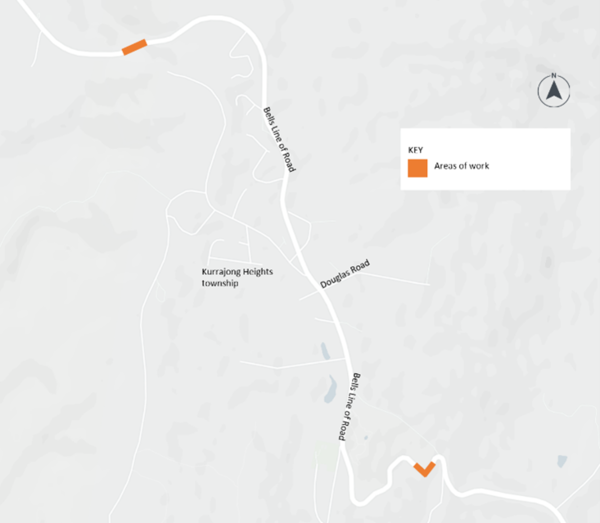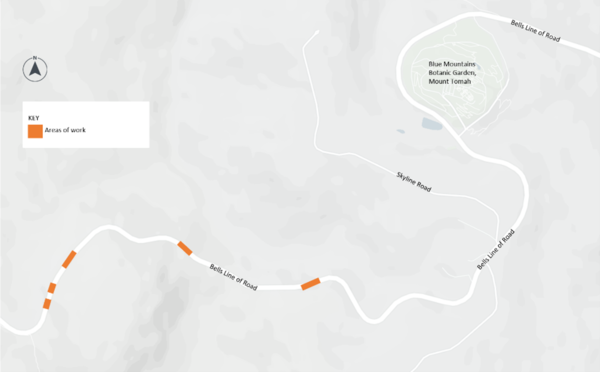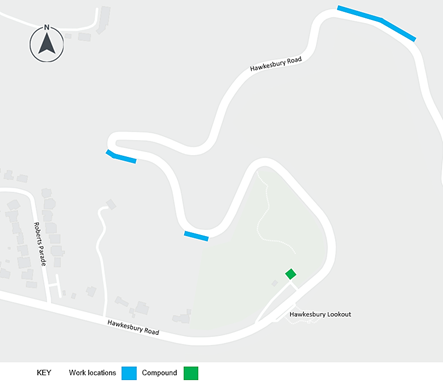Blue Mountains slope repair works
Project overview
Following the extreme weather event in 2022, there have been significant impacts to the Blue Mountains road network. Transport for NSW is carrying out pavement and slope repair work to return the Great Western Highway, Bells Line of Road, Putty Road and Hawkesbury Road to full capacity.

Latest News
April 2025 community update- Katoomba U-Turn Bay
View the April 2025 community update (PDF, 990.65 KB) for more information.
Project information
Slopes One to Five – Mount Tomah
The slopes range from 50 to 250 metres in length. Trees and other vegetation have grown into cracks and joints in the road cuttings. This is called ‘root jacking’ and it causes the slopes to become unstable.
Slopes Six to Seven - Kurrajong Heights
These slopes range from 215 to 300 metres in length. Trees and other vegetation have grown into cracks and joints in the road cuttings, and ‘root jacking’ has caused the slopes to become unstable.
Hawkesbury Road
Slope one
This slope is around 37 metres in length. Trees and other vegetation have grown into cracks and joints in the road cuttings. This is called ‘root jacking’ and it causes the slopes to become unstable. We will ‘rock scale’ around 56 square metres of the rock face – this means removing loose rocks.
Slope two
This slope is around 83 metres in length. It will require vegetation removal to prevent future root jacking occurring, and rock scaling. We will install around 30 rock bolts around three metres long to prevent further movement of the slope.
Slope three
This is the largest slope within the project being around 144 metres long and 15 metres high. This makes it more prone to rock falls and the fracturing of shales. Previous remediation measures, like catch fences and rock bolts, will be improved.
Putty Road
For information on slope repairs under way on Putty Road, please see the Putty Road project page.
Victoria Pass
For information on slope repairs under way on the Great Western Highway at Victoria Pass, please see the Victoria Pass Slope Repairs Project Page.
Great Western Highway at Katoomba U-Turn Bay
Following extreme weather in 2022, the slope beside the Great Western Highway at the Katoomba U-turn Bay was badly damaged and collapsed. Transport for NSW (Transport) is now permanently repairing the slope that underpins the U-turn Bay.
Construction of a new retaining wall and other work will make this slope much stronger and more flood resistant.
We are building a temporary access track below the collapsed slope, to allow us to build the gabion basket retaining wall, which is a wire cage wall filled with rocks. We area also installing improved drainage.
At the end of the project, we will restore the U-turn Bay pavement, build new kerb and gutter and install new guardrail and fencing.
How we will do the work
- Using chain saws and woodchippers to carry out vegetation removal
- Using excavators, a telehandler, elevated work platforms and abseiling equipment
- Dislodging loose rocks using hand tools (rakes, picks, shovels and crow bars) and then safely removing this material
- Drilling holes into the rock faces (attached to either an excavator or telehandler)
- Installing rock bolts ranging from three to eight metres in length to stabilise the slopes
- Grouting the rock bolts in place by a crew using rope access and elevated work platforms
- Applying rockfall netting over the rock face and pinning it into position where this is recommended
- Applying steel mesh to rock faces where shotcreting will take place
- Spraying shotcrete using a truck mounted pump.
How do rock bolts work?
- Rock bolts provide active reinforcement to joints within a slope
- They transfer the load from an unstable exterior to the much stronger interior of the rock mass
- This helps to reduce movement of the rock face.
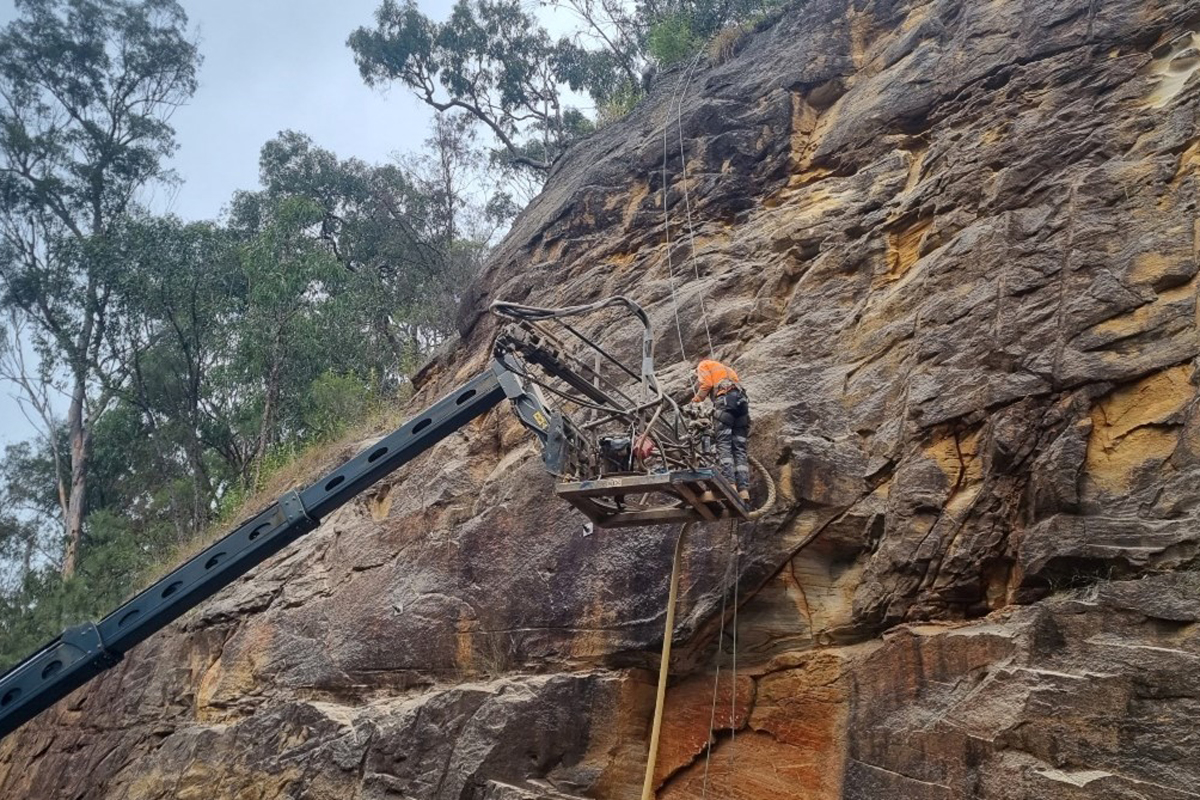
Above: Example of rock bolt installation used to stabilise slopes at Mt Tomah and Kurrajong Heights.
How does shotcreting work?
Shotcrete is a hardwearing material that sometimes provide a better slope stabilisation than soil nails.
Work crews will apply a wet mix of shotcrete to slope faces where this stabilisation method is a better solution.
Premixed cement will be pumped along high-pressure lines and sprayed at high velocity onto the hard surface and/or steel mesh, increasing overall strength of the slope surface.
Shotcreting avoids the need for costly formwork and reduces waste as we can carefully control the application of the concrete.
Vegetation removal and minimising our impacts
To ensure motorist safety, we need to remove more than 100 trees across the Kurrajong Heights sites. An estimated 16 trees will need to be removed from the Mount Tomah sites.
This is to stop the ‘root jacking’, where trees and other vegetation grow into cracks and joints in the road cuttings and cause the slopes to become unstable.
The tree clearing will include up to one metre behind the crest of each slope.
Transport and its contractors are committed to replanting more trees than must be removed. We are developing a landscape design which will be implemented once all stabilisation work is completed. We will ensure that native species are used in both areas.
Transport and its contractors are committed to minimising and mitigating environmental impacts. This can include:
- Identifying clearance limits to minimise native vegetation removal
- Holding pre-clearing inspections by ecologists
- Replacing and relocating habitat
- Using biodiversity offsets to address tree and hollow removal, after the full extent of local impacts have been calculated.
Project Documents
Project notifications
- February 2025 - Drain remediation work on Great Western Highway, near Katoomba from 9 February 2025 (PDF, 404.59 KB)
- January 2025 - Slope remediation work on Bells Line of Road, near Mount Tomah continuing from Thursday 23 January 2025 (PDF, 475.31 KB)
- January 2025 - Slope remediation work on bells Line of Road, bewteen Bell and Mount Tomah from 14 January 2025 (PDF, 220.62 KB)
- December 2024 - slope remediation work on Bells Line of Road, near Mount Tomah, continuing from Thursday 5 December 2024 (PDF, 265.43 KB)
- May 2024 - Slope repair work on Hawkesbury Road from late May to August 2024
- April 2024 - Slope repair work on Bells Line of Road, near Mt Tomah from Monday 22 April 2024 (PDF, 200.29 KB)
- April 2024 - Slope repair work on Bells Line of Road, near Kurrajong Heights from Monday 15 April 2024 (PDF, 197 KB)
Community updates
Media Releases
Maps
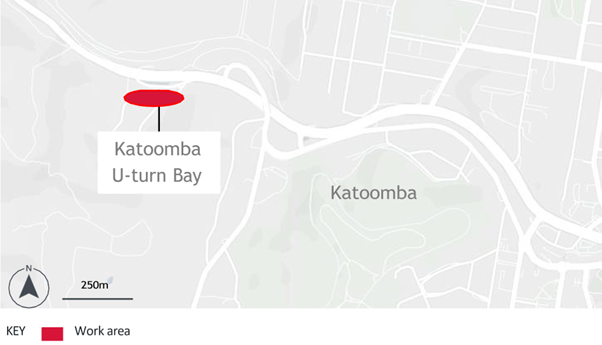
Katoomba U-Turn Bay Map
Contact us
For further information about this project, please contact:
Phone:1800 577 441
Email: info.parkland@ventia.com.au

